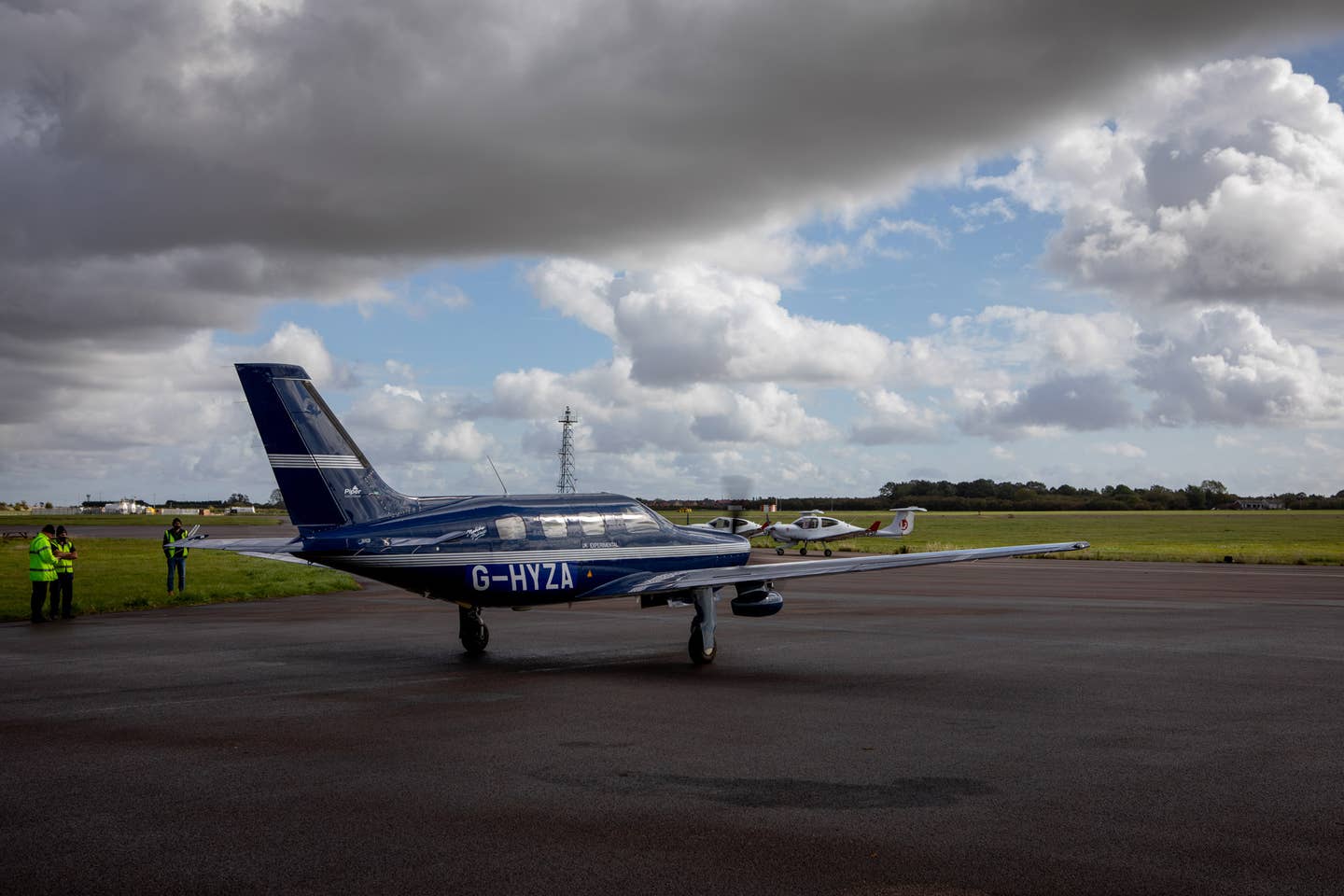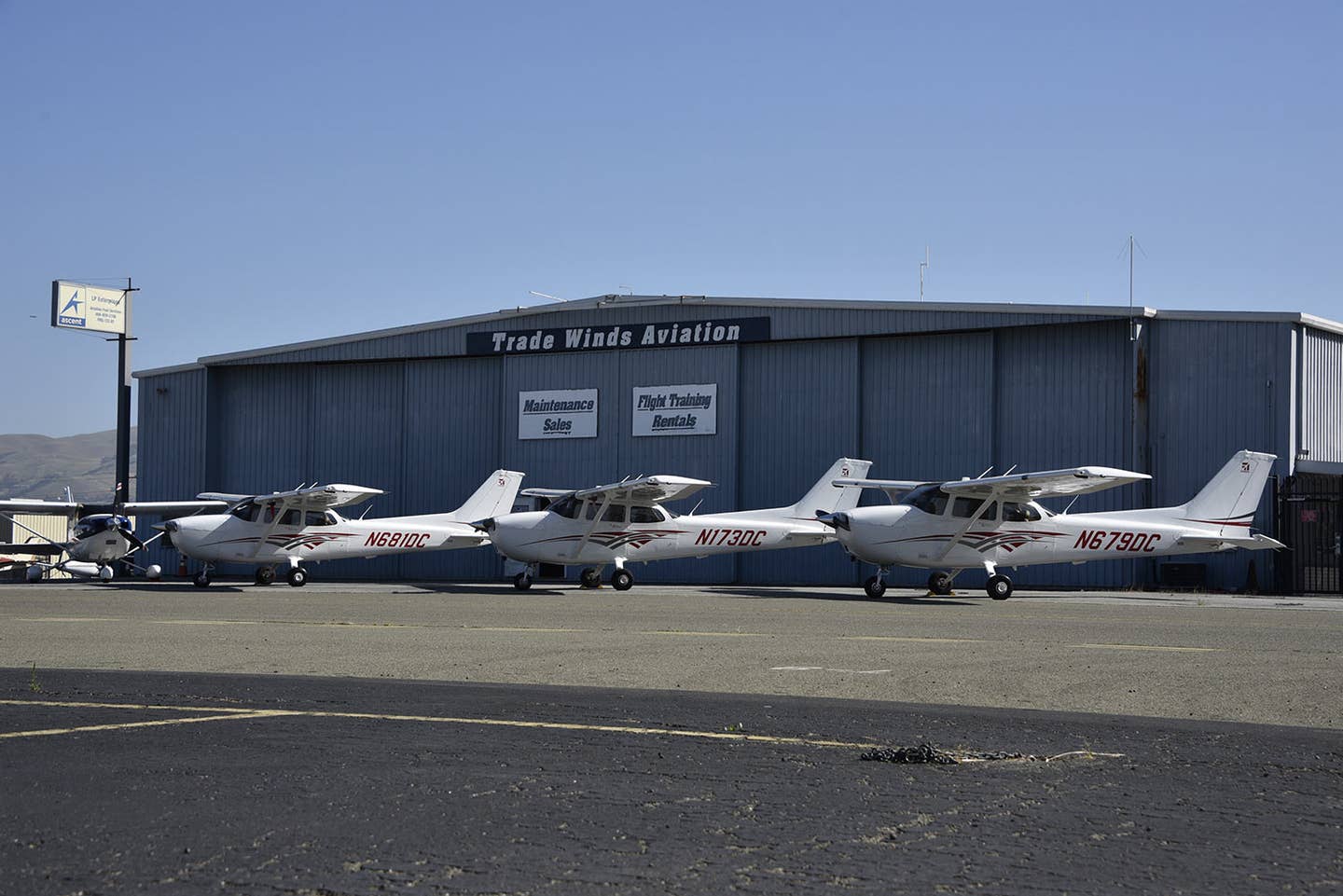From World War II Bombers to General Aviation Aircraft
A roughly 20,400-square-foot building that once housed a cadre of B-24 and B-25 Bombers during World War II is set to again shelter airplanes.

Michael Williamson and his wife Meagan stand in front of their hangar at Tullahoma Regional Airport. Chris Carter
A roughly 20,400-square-foot building that once housed a cadre of B-24 and B-25 Bombers during World War II is set to again shelter airplanes.
In the seven-and-a-half decades since the war ended, the property at Tullahoma Regional Airport (KTHA) in Tennessee has fallen into disrepair. So much so that the current owner, Michael Williamson, once briefly thought about scrapping his plans of restoring the site.
Having been vacant since the early 1990s, the site needed a long list of improvements to bring it back to a useful state.
“The roof was 40 percent caved in,” Williamson said. “Both valley drawings rotted completely and caved in. Metal sides completely rusted and bent up severely. Hangar doors’ windows were all cracked or broken. The doors were severely corroded at the bottoms, the door rails were all severely bent and corroded.
“You couldn’t see the concrete slab due to all the caved in roof material, water, and wildlife growing inside!”
Knowing the History
The full scope of damage was not a surprise, as much of it was visible from the exterior from a fair distance to Williamson. And as a longtime resident of Tullahoma—also home of Arnold Engineering and Developing Complex and Arnold Air Force Base—and airport tenant for several years, the neglected hangar at the eastern portion of the field was well-known to him. The building was constructed in 1941 by the Army Corps of Engineers.
“According to the old timers, they did do [aircraft] maintenance there.” In addition, a source references that the site was used during World War II for aircraft storage, as well as instructional purposes.
After the war was over, and the airport was no longer home to military training, the hangar was used by a manufacturing company for many years. Williamson believes they produced airframe parts, although he’s unsure of the company’s name and exact types of parts that they made. After this facility was closed nearly three decades ago, the hangar’s maintenance fell to the wayside as it sat unused.
Opportunity Knocks
In early 2021, Williamson heard from a friend that the property’s owner was ready to sell it. Williamson contacted them the week that he heard the hangar building was available and negotiated a sale price within a month, closing on the property in February.
Williamson was using space at the airport for his aircraft maintenance business and the adjoining property for a multifaceted manufacturing business—and he wanted to consolidate the two within the same property. He acquired the property because it would be a great place to house both companies next to each other with enough room to expand and offer new services as needed.
But, prior to either of the companies’ operations moving to the new site, Williamson had a lot of work to do. After navigating through the architectural design, permitting, and other planning steps, renovations earnestly began in June. Updates from previously completed and ongoing renovations can be found on the “The World War 2 Hangar at Tullahoma” Facebook page.
“We are roughly 80 percent through the project,” Williamson said. “We have completely stripped the exterior walls, hangar doors, and roof. We insulated the whole building, reskinned the sides, reskinned the roof, installed improved valley drains/gutters, and are in the process of restoring the hangar doors. The sprinkler system will be completed in the first week of November. Electrical will be done at the end of November along with the interior buildouts.”
Williamson said some renovations were more important than others.
“The biggest one for me is the hangar doors,” he said. “They were in really bad shape. My fabricators at the machine shop have done all the metal and structural work on the building, including the hangar doors. So, the obstacle has been manpower on my end since my guys are pulled between two businesses!
“The electrical, plumbing, interior build outs and sprinklers are all being worked concurrently. I hope to have all that done by mid-November.”
Once those efforts are completed, the 18 according rolling hangar doors (each being 10 feet wide by 20 feet tall) will open once again. And aircraft owners will then officially have another indoor storage option at Tullahoma Regional Airport.
The Specifics
The hangar portion of the building is 180 feet by 100 feet and takes up the section of the building adjacent to the ramp and taxiway. This percentage of the building will host aircraft maintained by Williamson Aviation, as well as offer spots for shared aircraft storage.
The back half of the building is also under renovation at the same time as the hangar, which will become leased office space for several businesses. The initial plan was for Williamson’s manufacturing business, Lynchburg Machine Tool, to be kept there. But space needs for the business demanded that he build a new building behind the hangar instead.
Williamson expects that within the hangar there will be ample room for 25 light piston airplanes, or a lower number of single-engine turboprops or light twins. In order to bolster the available space within the shared hangar, Williamson is set to install aircraft lifts to optimize the available floor space. He believes this will create places for five to 10 more airplanes.
This new hangar option will help to rectify the overall lack of storage availability in the area for general aviation aircraft.
“The community hangars are full,” Williamson said. “Mine is filling up quick as the word is getting out. In fact, good luck finding hangar space in Tennessee!”
Williamson says the need for indoor aircraft storage extends to northeastern Alabama, with several parties on the prospective tenant list coming from that area.
A Nod to the Past
And with these renovations ushering in a new era for the facility, Williamson has been careful not to forget its important past. Its use during World War II continues to be top of mind throughout the restoration process and beyond. Most importantly, he has leveraged the building’s aviation history by successfully petitioning for its addition to the National Register of Historic Places.
By acquiring the derelict World War II-era building, Williamson found a way to preserve history, as well as positively impact his own businesses, and serve fellow aviators needing to hangar their aircraft.

Sign-up for newsletters & special offers!
Get the latest FLYING stories & special offers delivered directly to your inbox






